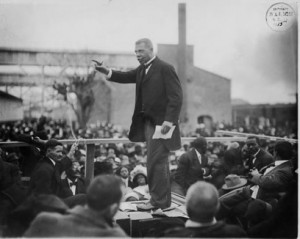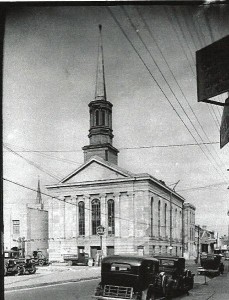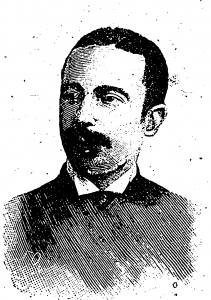The Wizard of Tuskegee in New Orleans
Booker Taliaferro Washington’s life’s work garnered for him the esteem of Americans of all races and admirers from around the world. “Builder of a Civilization,” “Wizard of Tuskegee,” “Leader of His People” – These titles have all been given to this man who rose from bondage to establish a great university and become the most recognized figure of his race. The citizens of New Orleans had occasion three times to welcome Dr. Washington to their city – in 1899, 1902, and 1915. Washington had numerous supporters and political allies in New Orleans such as James Lewis, Walter L. Cohen, and James Madison Vance. His photographer, Arthur P. Bedou (featured in separate post on this blog) was also a New Orleanian.
Booker T. Washington speaking in Louisiana, 1915. Photograph by Arthur Paul Bedou.
Upon his first visit to the city on 10 November 1899, just four years after his famous Atlanta Exposition address, political leader, Colonel James Lewis, offered Dr. Washington the hospitality of his home at 2415 Canal Street, just opposite the campus of Straight University. He had already agreed however to be received at the home of James E. Porter, a labor leader among the city’s longshoremen, who resided at 822 Octavia Street in the Uptown area. Upon arriving at the train depot with much fanfare at 7:30 a.m., Washington was led to the Porter home, after which he toured the city’s four black universities, its leading public schools, and the city hall (the famed Gallier Hall), where he was received by Mayor Walter C. Flower. The climax of his visit was a public address at the Central Congregational Church, one of New Orleans’ leading black congregations, then located at South Liberty and Gasquet streets.
Three years later on 31 October 1902, Dr. Washington again visited the Crescent City. On this occasion, he did indeed accept the hospitality of Colonel and Mrs. James Lewis at their home on Canal Street. He gave an address on education at Straight University that afternoon which was attended by many of the city’s black educators. That evening a large crowd assembled at the famed Washington Artillery Hall (Saint Charles Avenue at Julia Street), one of the Carnival palaces of yesteryear, to hear the renowned visitor speak. He was introduced by the Honorable Ernest B. Kruttschnitt, Superintendent of the Public Schools.
Washington’s final trip to New Orleans was on 13 April 1915, the first portion of a grand tour through Louisiana. After being met at the railroad station by a large committee, Dr. Washington and his party were ushered to the home of political and business leader Walter L. Cohen at 2320 Dumaine Street for a grand breakfast. His initial talk, held in Burns Arena, just off Canal Street, was made to an overflowing crowd of several thousand. A public school holiday was declared so that the schoolchildren of the city might attend the morning address. A banquet was given in the afternoon at the Central Congregational Church where many of the city’s black business, political, and social leaders were present. The many who did not hear Dr. Washington in the morning were able to do so in an evening address rendered at the Dauphine Theatre on the venerable old street bearing that name.
Central Congregational Church (1882-1934) – South Liberty at Gasquet (now Cleveland) streets.
In all of his talks, Washington encourage thrift and industry on the part of his people. He offered thanks to his white listeners for the efforts they had made towards the Negro race. He encouraged his people to take advantage of educational opportunities and to continue to foster good relations between the races. He noted that he was thankful to observe the conditions of the race in Louisiana. His remarks were punctuated by humorous anecdotes, a hallmark of his oratory often forgotten today.
Sadly, all but two of the sites connected with Booker T. Washington’s visits to New Orleans are lost to time. The old Central Congregational Church at Liberty and Cleveland, the Lewis home, the Cohen home, Washington Artillery Hall, Dauphine Theatre, and Burns Arena have all long since been demolished. The imposing edifice of Gallier Hall still readily meets each passing streetcar, much as it would have during Dr. Washington’s visit. The other surviving site, the home of James E. Porter, at 822 Octavia Street still exists as a private residence.
James Edward Porter (1856-1916).
James Edward Porter served for over three decades as secretary of the Longshoremen’s Protective Union Benevolent Association. A native of Mississippi, born in 1856, he was married to Miss Georgia Cain in 1884. He was a former student at the New Orleans University and a messenger in the State House of Representatives during the year 1875. A member of numerous organizations and the Felicity Street Baptist Church, he died on 20 November 1916 in his home, where seventeen years earlier he had welcomed the “Wizard of Tuskegee.”
Sources: James Lewis to Booker T. Washington, 19 October 1899, The Booker T. Washington Papers: 1899-1900, page 238; The Daily Picayune, 21 November 1916, page 4; The Chicago Defender, 2 December 1916, page 6; The Weekly Pelican, 4 June 1887, page 1.
J.C.H.






Booker T. Washington is one of my favorite people. New Orleans is one of my favorite places. I have not had the priviledge to visit nor was I around when Mr. Washington lived. However, I enjoy reading the history of both. jacqueline
I would love to know the history of Central Congregational Church from its old site – pictured in this blog. What happened? Why did it move? Anyone researching this for a future blog?
Booker T. Washington High School has quite a history. The part I hope you will share is of the New Orleans Symphony playing in the Booker T. Washington High School Auditorium when Jean Maloney played Tchaikowsky’s Concerto because African Americans, especially the women, were not allowed to play on the concert stage at Symphony Hall in New Orleans. The place was packed, the concert great and needs to be recorded someplace from the racial perspective and the Booker T. stepping in to make this possible.
Madame Donaldson, we are working on something on Central Congregational – we agree that like so many congregations in our city. it has a very rich history. We have a blog post on B. T. Washington High School and its auditorium. Thank you for recounting the role it played as a concert venue when so many other places were closed to New Orleanians of color.
When you look at the Churches, don’t forget St. Luke’s Episcopal with a very long history. My great-grandfather was priest at St. Luke’s in the early 1900’s. He came to New Orleans to pastor St. Luke’s and unusual for that time, he had a doctorate in theology which he received in 1906 and was ordained deacon and priest in 1906-1907.
I am in a place where all Blacks are considered ignorant, on welfare and only achieving because of White’s who back them and help them and allow them to succeed. That is so not true and our history is not one which started in the 1960’s – it goes back further than that. To acknowledge such one has to admit to racism’s existence and the horribleness of having taken away so many opportunities from so many African Americans.
Just think what could have been accomplished but for the racism and sexism in this society – which continues very little abated to this day.
The tragedy in so many lives because of the need to keep talented, intelligent, lovely people down.
She was my Grandmother
My grandmother, Rilda Augustine Boudreaux-Moore, was only 5 years old on Mr. Washington’s last visit; but she was one of the school-children who went to see him. She relayed her memory of the event to me when I was a little girl. She was very impressed with Mr. Washington even as a small child and was proud to have met him on that occasion. She remembered he had a high pitched voice that she found strange (to say the least).
She went on to become Salutatorian in the 1st graduating class of Xavier University, I remember the day and the story well because she also showed me her real lambskin diploma from Xavier which impressed me as much as her encounter with Booker T. Washington impressed her.
Thanks so much for sharing this story…I am searching for stories from the Creoles from Southwest Louisiana / Lafayette Carencro/Breaux Bridge…
I HAVE A QUESTION THAT IS INDIRECTLY RELATED B.T. WASHINGTON AND THE SCHOOL(S) IN NEW ORLEANS NAMED FOR HIM. BACK IN 1937-’38-’39’-’40, MY BROTHER AND I WERE LIVING WITH FOSTER PARENTS. MY FOSTER FATHER WAS PRINCIPLE OF A GRAMMER SCHOOL WHICH I THINK WAS NAMED AFTER B.T. WASHINGTON. IN 1940, RELATIVES FROM MISSISSIPPI TOOK US OUT OF FOSTER CARE; BUT I SEEM TO RECALL THAT A NEW B.T. WASHINGTON WAS GOING TO TAKE THE NAME OF MY FOSTER FATHER’S SCHOOL. CAN YOU SHINE ANY LIGHT ON THIS? I’D REALLY BE HAPPY TO DISCOVER THE NAME OF MY FOSTER PARENTS…THAT WOULD BE QUITE A BONUS.